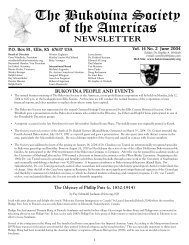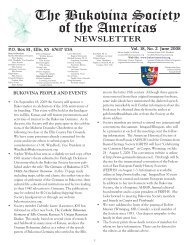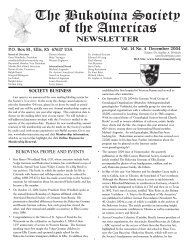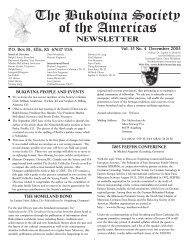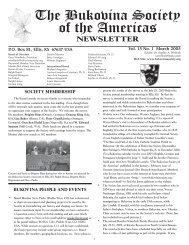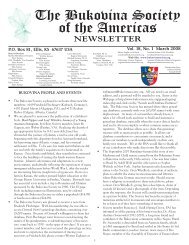March 2004 Vol. 14 #1 - Bukovina Society of the Americas
March 2004 Vol. 14 #1 - Bukovina Society of the Americas
March 2004 Vol. 14 #1 - Bukovina Society of the Americas
Create successful ePaper yourself
Turn your PDF publications into a flip-book with our unique Google optimized e-Paper software.
In 1823 we find Adam Rau as Neu-Itzkany’s “school director”<br />
and after him <strong>the</strong> teacher Johann Proll from Czepan in<br />
Transylvania. As far as can be determined, <strong>the</strong> teacher Johann<br />
Novak was entrusted with <strong>the</strong> education and training <strong>of</strong> <strong>the</strong><br />
children in 1871. His successors included Jakob Serfass,<br />
Bernhard Köhler, Heinrich Kaufmann, Karl Völpel, Friedrich<br />
Schneikart Sr., Franz Serfass, and lastly Wilhelm Schwarzmann<br />
from Bessarabia. Despite material sacrifices <strong>the</strong> school continued<br />
in operation as an accredited German Protestant private school<br />
until <strong>the</strong> transfer <strong>of</strong> <strong>the</strong> <strong>Bukovina</strong> Germans [to Germany] in<br />
1940.<br />
Religious services for <strong>the</strong> community posed great difficulties.<br />
From 1791 Neu-Itzkany was served by Pastor Stefan Daniel<br />
Wilhelm Hübel from Alt-Fratautz. In 1792 Pastor Hübel<br />
transferred to Milleschoutz, where in 1795 he replaced Pastor<br />
Andreas Schwarz from Waltersdorf in Transylvania. When in<br />
1859 <strong>the</strong> parsonage <strong>of</strong> Illischestie was established, its pastor<br />
Franz Samuel Traugott Gorgon also served Neu-Itzkany until his<br />
death in 1900. His successor from October 1901 to <strong>the</strong> end <strong>of</strong><br />
June 1907 was Pastor Josef Folwartschny, followed by Pastor<br />
Immanuel Gorgon, <strong>the</strong> son <strong>of</strong> Illischestie’s first pastor. From<br />
1903 Neu-Itzkany had its own pastor, August Hargesheimer<br />
from Ugartsthal in Galicia, who was succeeded two decades later<br />
by Pastor Graef from Transylvania.<br />
Despite <strong>the</strong> fact that Neu-Itzkany was one <strong>of</strong> <strong>the</strong> smaller German<br />
communities in <strong>Bukovina</strong>, its inhabitants managed to<br />
achieve a noteworthy prosperity, since trade and even industry<br />
found fruitful ground in <strong>the</strong> village and its environs. In 1908<br />
Itzkany was <strong>the</strong> first rural community in <strong>Bukovina</strong> to install<br />
electricity. Aside from <strong>the</strong> well-known large sugar refinery, Neu-<br />
Itzkany also had an oil refinery and a factory for <strong>the</strong> production<br />
<strong>of</strong> wooden nails. A natural outcome <strong>of</strong> <strong>the</strong> community’s economic<br />
success was its many cultural and civic associations,<br />
superseding that <strong>of</strong> many o<strong>the</strong>r communities in our vicinity. As<br />
early as 1899 an agricultural association was founded. In 1911<br />
Heinrich Kaufmann served as its director and Jakob Germann<br />
its deputy director. In <strong>the</strong> same year <strong>the</strong> “Savings and Loan<br />
Association” was established with some 100 members, and in<br />
1911 Jakob, son <strong>of</strong> Wilhelm Germann, became director with<br />
Ludwig Hodel <strong>the</strong> deputy director. The year 1908 witnessed <strong>the</strong><br />
establishment <strong>of</strong> <strong>the</strong> regional branch <strong>of</strong> <strong>the</strong> Association <strong>of</strong><br />
Christian Germans in <strong>Bukovina</strong>. In 1925 August Hargesheimer<br />
served as its director with Johann Mohr, son <strong>of</strong> Wilhelm, its<br />
deputy director.<br />
Regarding <strong>the</strong> job-related activities <strong>of</strong> <strong>the</strong> inhabitants <strong>of</strong> Neu-<br />
Itzkany, we have some statistics from 1937 on <strong>the</strong> village’s 150<br />
families with a male head-<strong>of</strong>-household. The data shows that<br />
forty-four (26.8 per cent) were in agriculture, thirty (18.3 per<br />
cent) in crafts with a side pr<strong>of</strong>ession, five (3.3 percent) in trade<br />
and commerce, eleven (6.7 percent) were workers and day-wage<br />
laborers, and seventy-four (45.2 percent) were hired help and in<br />
<strong>the</strong> liberal pr<strong>of</strong>essions. Those in <strong>the</strong> last category found outside<br />
employment with <strong>the</strong> nearby railroad and its <strong>of</strong>fices, in <strong>the</strong> sugar<br />
6<br />
refinery, and in <strong>the</strong> slaughterhouse associated with <strong>the</strong> large<br />
smoked products plant in nearby Burdujeni.<br />
The possibility <strong>of</strong> outside employment worked favorably for <strong>the</strong><br />
agricultural sector since <strong>the</strong> hereditary division <strong>of</strong> land did not<br />
have to come into play as <strong>of</strong>ten as in o<strong>the</strong>r communities. With<br />
an average <strong>of</strong> 4.1 hectares per family <strong>the</strong> village was in this<br />
respect <strong>the</strong> best situated in <strong>the</strong> region.<br />
In conclusion, <strong>the</strong> heads <strong>of</strong> families living in Neu-Itzkany in<br />
<strong>the</strong> last decade before <strong>the</strong> resettlement were in <strong>the</strong> occupational<br />
categories cited below:<br />
AGRICULTURAL FARMSTEADS. Franz Bessai, Samuel<br />
Bessai, Jakob and Peter Blomann, Gustav Gauer, Adam<br />
Germann II, Jakob Germann II, Johann Germann and his<br />
fa<strong>the</strong>r Ludwig, Johann Germann (son <strong>of</strong> Karl), Josef and<br />
Wilhelm Germann (sons <strong>of</strong> Josef), Karl Germann, Philipp<br />
Germann and his son Jakob, Johann Hermann II, Johann<br />
Hodel (son <strong>of</strong> Adam), Johann Hodel II, Wilhelm Hodel, Josef<br />
Keller, Jakob Kornelson, Johann Kornelson, Wilhelm<br />
Kornelson, Ernst Massier, Franz Mohr, Karl Mohr, Peter Mohr,<br />
Wilhelm Mohr (son <strong>of</strong> Peter), Franz Nähr, Jakob Nähr, Johann<br />
Nähr, Ernst Rau, Jakob Rau, Wilhelm Rau, Johann Wagner.<br />
TRADES AND BUSINESSES. Demeter Bogatu, Erwin Frank,<br />
Wilhelm Germann, Jakob Hodel, Ludwig Mohr, Ludwig<br />
Praglowski, Friedrich Reim and Karl Reim.<br />
IN PRIVATE AND OFFICIAL EMPLOYMENT. Adam<br />
Bessai, Nicolaus Cerski, Adolf Czmiel, Jakob Czurau, Johann<br />
and Philipp Dudutza, Eugen Dufek, Amalie Engel, Friedrich<br />
and Otto Engel, Ludwig Germann, Adam Haidu, Gustav<br />
Hartmann, Johann and Amalie Hektor, Arnold and Eduard<br />
Hodel, Johann and Rudolf Hodel, Theresia Hodel, Wilhelmine<br />
Hodel, ? Hrudei, Otto Hube, Franz Keller, Johann Keller,<br />
Katharina Kerth, Wilhelm Kerth, Ludwig Klimkowski, Adam<br />
Kornelson, Erwin and Adele Kornelson, Jakob and Otto<br />
Kornelson (sons <strong>of</strong> Johann), Josef Kornelson, Wilhelm<br />
Kornelson, Wilhelm Kornelson (son <strong>of</strong> Johann), Christine<br />
Kuba, Jakob and Adolf Kubinski, Karl Kubik, Ferdinand<br />
Kuschera, ? Kwasko, Karl Ma<strong>the</strong>, Franz Marko, Friedrich Mock,<br />
Adam Mohr, Jakob and Johann Mohr (sons <strong>of</strong> Peter), Johann<br />
Mohr II, Johann Mohr (son <strong>of</strong> Wilhelm), ? Pelweski, Otto<br />
Pertisch, Franz Praglowski, Adam Radmacher, Karl Rakoczy,<br />
Georg Salhorniak, ? Sauer, Karl Schäfer, Friedrich Schneikart,<br />
Wilhelm Schwarzmann, ? Seile, Jakob Silzer, Wilhelm Smolak,<br />
Johann Smutne, Theodor Schneikart, Johann Specht, Arthur<br />
Strobel, Otto Turkowski, Franz Weber, Heinrich Wegemann,<br />
Johann Werbetz, Hans Werskla, Hans Wilk, Amalie<br />
Zimmermann and Adolf Zybaczinski.<br />
*Josef Talsky, “Neu-Itzkany,” in Bukowina: Heimat von<br />
Gestern,” eds. Erwin Massier, Josef Talsky, B.C. Grigorowicz,<br />
trans. Sophie A. Welisch (Karlsruhe: Selbstverlag “Arbeitskreis<br />
Bukowina Heimatbuch,” 1956), pp. <strong>14</strong>1-<strong>14</strong>4.



